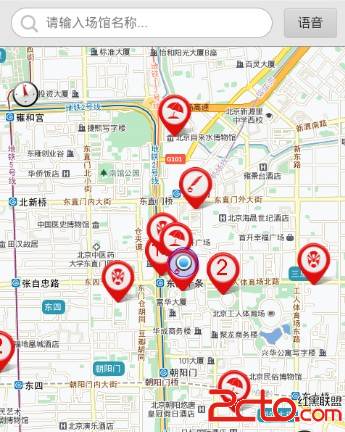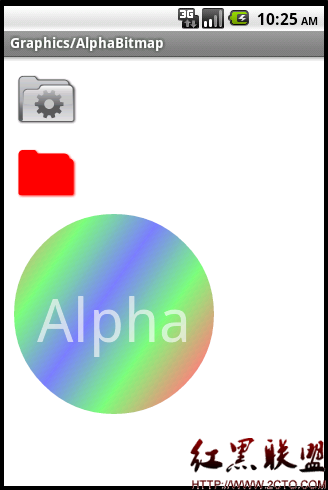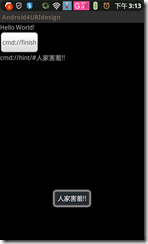Android View 的刷新机制
今天学习android VIEW的刷新机制,之前一直以为是调用VIEW的刷新就自己调用刷新函数。今天学习了一下view的刷新机制,还是表示学习到很多的知识啊。
感想就是自己要多阅读android的源代码,其实很多的消息传递等等的机制,都是通过阅读android的源代码得到的,所以有事没事就去看源代码玩吧~
好了,来到正题,关键的一句话就是:
在Android的布局体系中,父View负责刷新、布局显示子View;而当子View需要刷新时,则是通知父View来完成。
步骤就是:
1、调用子View的invalidate()
2、跳转到上一层的invalidateChild函数中区
3、在一次调用invalidateChildInParent的函数一次层层刷新
4、具体的刷新后续操作,我就不清楚了,调用invalidate最终在代码上就在invalidateChild终止了的,所以表示有点点不清晰,求各位大牛介绍一下吧。。。。。?在此谢过了。。
让我来阅读源代码:
首先在View类中:
/**
* Invalidate the whole view. If the view is visible, {@link #onDraw} will
* be called at some point in the future. This must be called from a
* UI thread. To call from a non-UI thread, call {@link #postInvalidate()}.
*/
public void invalidate() {
if (ViewDebug.TRACE_HIERARCHY) {
ViewDebug.trace(this, ViewDebug.HierarchyTraceType.INVALIDATE);
}
if ((mPrivateFlags & (DRAWN | HAS_BOUNDS)) == (DRAWN | HAS_BOUNDS)) {
mPrivateFlags &= ~DRAWN & ~DRAWING_CACHE_VALID;
final ViewParent p = mParent; //获得父类View的对象
final AttachInfo ai = mAttachInfo;//获得匹配
if (p != null && ai != null) {
final Rect r = ai.mTmpInvalRect;
r.set(0, 0, mRight - mLeft, mBottom - mTop);//设置本View的尺寸,其实就是大小没有设置位置
// Don't call invalidate -- we don't want to internally scroll
// our own bounds
p.invalidateChild(this, r); //调用父类的刷新函数
}
}
}
下面我们来到Viewgroup对象:
在invalidate中,调用父View的invalidateChild,这是一个从第向上回溯的过程,每一层的父View都将自己的显示区域与传入的刷新Rect做交集。
/**
* Don't call or override this method. It is used for the implementation of
* the view hierarchy.
*/
public final void invalidateChild(View child, final Rect dirty) {
if (ViewDebug.TRACE_HIERARCHY) {
ViewDebug.trace(this, ViewDebug.HierarchyTraceType.INVALIDATE_CHILD);
}
ViewParent parent = this;
final AttachInfo attachInfo = mAttachInfo;
if (attachInfo != null) {
final int[] location = attachInfo.mInvalidateChildLocation;
// 刷新子View的位置
location[CHILD_LEFT_INDEX] = child.mLeft;
location[CHILD_TOP_INDEX] = child.mTop;
// If the child is drawing an animation, we want to copy this flag onto
// ourselves and the parent to make sure the invalidate request goes
// through
final boolean drawAnimation = (child.mPrivateFlags & DRAW_ANIMATION) == DRAW_ANIMATION;
// Check whether the child that requests the invalidate is fully opaque
final boolean isOpaque = child.isOpaque() && !drawAnimation &&
child.getAnimation() != null;
// Mark the child as dirty, using the appropriate flag
// Make sure we do not set both flags at the same time
final int opaqueFlag = isOpaque ? DIRTY_OPAQUE : DIRTY;
do {
View view = null;
if (parent instanceof View) {
view = (View) parent;
}
if (drawAnimation) {
if (view != null) {
view.mPrivateFlags |= DRAW_ANIMATION;
} else if (parent instanceof ViewRoot) {
((ViewRoot) parent).mIsAnimating = true;
}
}
// If the parent is dirty opaque or not dirty, mark it dirty with the opaque
// flag coming from the child that initiated the invalidate
if (view != null &&am
补充:移动开发 , Android ,




